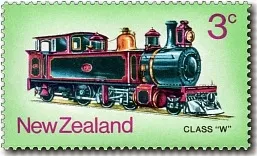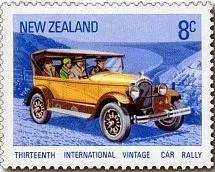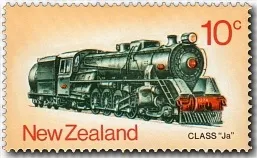During the mid-1970s New Zealand issued a yearly set of stamps featuring vintage transport. I think it might be better if we view these sets in one group rather than individual issues. I have combined these issues to make an interesting series of 30 stamps depicting the development of early transport in New Zealand. Maybe one day I might return to view each issue in greater detail.
The cars depicted on the stamps reflect the early development of road motor vehicles in New Zealand with the cars set against early New Zealand scenic backgrounds. I am not sure if at this point they were intended to be part of a series on vintage transport.
1972 Vintage Cars.
It all started in 1972 with New Zealand issuing a six value set to mark the 13th International Vintage Car Rally which was held in New Zealand in February 1972. The rally was held at Richmond, Nelson, and attracted entries from all over the world. The cars depicted on the stamps reflect the early development of road motor vehicles in New Zealand with the cars set against early New Zealand scenic backgrounds. I am not sure if at this point they were intended to be part of a series on vintage transport.
1895 Benz - 3c. 1904 Oldsmobile - 4c.
Christchurch with the cathedral. Auckland, One Tree Hill.
1914 Model T Ford - 5c. 1915 Cadillac Service Car - 6c.
Near Lumsden, Southland. Buller Gorge.
1924 Chrysler - 8c. 1923 Austin 7 - 10c.
Paekakariki Hill. Lake Waikaremoana near Bluff.
1973 Vintage Trains.
The vintage theme was continued in 1973 with an issue depicting four New Zealand steam locomotives. This issue was rather topical as the last of the steam locomotives had just been withdrawn for service in 1971 and replaced by diesel engines. This set can also be viewed on my Trains of New Zealand page.
"W" Class Tank Locomotive - 3c "X" Class Locomotive - 4c.
The "W" Class tank locomotive was the first engine built by the New Zealand Railways Workshops in 1889. It was very useful for branch line and suburban passenger work. The "W" Class was followed by other tank locomotives of similar but more modern design including the famous "Wab" Class.
The "X" Class locomotives first built in 1908 were among the first four-cylinder compound locomotives in the world. They were specially designed for heavy service over the steep grades of the North Island Main Trunk.
"Ab" Class Locomotive - 5c. "Ja" Class Locomotive - 10c.
The "Ab" Class locomotive was for many years the Railways' maid of all work and between 1915 and 1926, 141 were built. They could be found roaming all over the NZR rail system doing anything from mainline passenger work to branch line freights. No. 608 "Passchendale" the locomotive depicted on the stamp was one of two engines of this class to carry a memorial plaque.
The "Ja" Class was the last steam locomotive class to be built by the New Zealand Railways and No. 1274 was the last of 35 of this class built. The "Ja" was an upgraded version of the "J" class designed for mainline passenger and fast freight work.
1974 Vintage Aircraft.
New Zealand's first unofficial air post delivery was believed to have made in 1914 when a parcel containing a letter addressed to a South Canterbury farmer was dropped from the cockpit of a bi-plane. New Zealand's Official airmail services began in 1919. Continuing this series featuring vintage transport, this set of four stamps depicted aircraft involved in important stages in the history of New Zealand's airmail transportation.
Boeing Seaplane - 3c. Lockheed Electra - 4c.
On 16 December 1919, a Boeing Seaplane piloted by Captain Bolt had the distinction of flying the first officially assigned airmail in New Zealand from Auckland to Dargaville. The Boeing Seaplane covered the 112 miles in just over one hour thirty minutes.
Introduced by Union Airlines in 1937, the Lockheed Electra was a 10 passenger craft with a 188 mph cruising speed. "Kauka" the Electra featured on the stamp was one of three later taken over by National Airways Corporation (NAC) now Air New Zealand. It was the last used by NAC and it can now be seen in retirement at Auckland's Transport and Technology Museum.
Bristol Freighter - 5c. Short Flying Boat - 23c.
The Bristol Freighter was a cargo plane operated throughout New Zealand by Safe Air Limited (previously Strait Air Freight Express Limited) and was a regular carrier of mail after 1958.
The last stamp features the Short Flying Boat "Aotearoa" which belonged to Tasman Empire Airways Limited (TEAL) now Air New Zealand. The "Aotearoa" made the inaugural flight from Auckland to Sydney beginning a mail and passenger service.
1975 Vintage Ships.
The theme of vintage transport was continued in 1975 with this six value set showing vintage sailing ships which represent some of the more important classes of sailing ships found in New Zealand. I must admit I think there is something beautiful about a sailing ship being driven through the water by the wind under a full rig of sails.
Scow 'Lake Erie'. Schooner 'Herald'.
Scow 'Lake Erie' - 4c
Built, in 1873 in New Zealand by S Meiklejohn at Omaha, the 'Lake Erie' was the first of a new type of vessel to New Zealand. The scow is a flat decked, square sterned, bluff-bowed, and flat bottomed vessel which was capable of sailing up shallow creeks and remaining on an even keel when aground. The 'Lake Erie' carried 80 tons cargo of logs and timber. Often scows were loaded while they sat on the beach over low tide, to be refloated again as the tide came in.
Schooner 'Herald' - 5c
Built, in 1826 by H Williams & G Mair at Paihia, the Herald was the first vessel to be built for the Church Missionary Society by Rev Henry Williams and Gilbert Mair (chiefly known for his trading activities at Wahapu, and later Surveyor of Ships at Russell). The 'Herald' only had a short life of two years trading around New Zealand and across the Tasman to Sydney, before she was wrecked at Hokianga in 1828.
Brigantine 'New Zealander'. Topsail Schooner 'Jessie Kelly'.
Brigantine 'New Zealander' - 8c.
Built, in 1828 by Raine, Ramsay & Brown at Horeke on the Hokianga Harbour, the 'New Zealander' was described as a brigantine since she carried a full set of square sails on her forward mast. For many years she traded around New Zealand and to Australia until she was wrecked at Table Cape, Mahia Peninsula in 1836.
Topsail Schooner 'Jessie Kelly' - 10c
Built, in 1866 by H Niccol at Devonport. Niccol was for many years Auckland's foremost shipbuilder, his yard being at Mechanic's Bay, and later transferred to a patent slip he built at North Shore. The 'Jessie Kelly' was known as a topsail schooner because she carried square sails, known as topsails on the foremast. Compare this with the schooner the Herald above.
The two vessels on the higher values not built in New Zealand.
Barque 'Tory'. Full Rigged Clipper 'Rangitiki'.
Barque 'Tory' - 18c.
The Tory was built in 1834 for Josephy Soames in England. She was purchased by the New Zealand Company in 1839 to bring 35 immigrants headed by Col Wakefield as the advance party for the first organised settlement of New Zealand. She arrived in Queen Charlotte Sound on 17 September 1839 and entered Port Nicholson, Wellington three days later.
Full Rigged Clipper 'Rangitiki' - 23c
Built, in 1863 by M Samuelson of Hull. Tonnage - 1227 gross. One of the original four ships bought by the newly formed New Zealand Shipping Company in 1873. 'Rangitiki' was in many ways the pride of their fleet of sailing ships, being one of the largest ever owned by the Company, and a record pacemaker. She also completed an astonishing career of some 60 years service, during which she played an important part in bringing immigrants to New Zealand.
1976 Vintage Farm Transport.
1976 saw vintage farm equipment being featured in the transport issue. As New Zealand relies on pastoral exports the equipment and transport needs of farmers was important.
Gig - 6c. Thornycroft Lorry (1923) - 7c.
The gig and its four-wheeled counterpart, the buggy, was like the car of the farmer used to transport himself and his family. They were usually drawn by a light harness horse and the gig's light construction allowed quick transport to get around.
The motor lorry quickly established itself in the New Zealand farming scene as a useful vehicle able to carry or pull a variety of loads. The model for this stamp is a Thornycroft B T lorry, manufactured at Basingstake in England, designed to carry a load of 2.5 tons, and with a governed maximum speed of 18 mph. The Thornycroft is one of many makes of lorry which were replacing horse-drawn vehicles on New Zealand's roads in the 1920s.
Scandi Wagon - 8c. Traction Engine - 9c.
The Scandi, or bush wagon, was developed by the Scandinavian immigrants who were brought to New Zealand in 1872 and established the settlements of Dannevirke and Norsewood in the Seventy-Mile Bush in Southern Hawke's Bay. The difficult conditions encountered by the settlers demanded a wagon of rugged construction. The Scandi is simple in design, has no springs, a low deck, and is characterised by the unusual wheel construction.
It is not known when the first traction engine arrived in New Zealand but many were imported from the 1890s until the late 1920s. Traction engines were similar to a railway steam locomotive except they were not confined to rails which meant they could be used extensively in all parts of the country, on road haulage, agricultural work, timber milling, and general contracting.
Wool Wagon - 10c. Cart - 25c
Wool wagons were larger, four-wheeled vehicles drawn by teams of bullocks or horses. They were used to haul loads of wool bales from the back-country sheep stations to the coast. A high, wide deck allowed a greater number of wool bales to be carried and kept the load above water level when fording rivers, and when the wagon was driven into the sea to load ships standing off the beach.
The farm cart had always been an essential piece of the European farmer's equipment and the idea was quickly imported by the New Zealand farmer in the horse-drawn era. Probably the most common of all farm vehicles, it was pulled by a single draught horse and used for everyday haulage carrying a wide variety of load, both around the farms and on the roads.
1977 Vintage Fire Fighting Appliances.
The last issue in this series of vintage vehicles was the early equipment used by firemen. As can be seen on the stamps, these early vehicles were pulled by horses of the firemen themselves.
Merryweather Manual Pump - 1860 - 10c.
Manual fire engines were used in the early years by most New Zealand Fire Brigades. The one shown is a smaller manual pump pulled to the fire by manpower while larger vehicles were horse-drawn. The pump was operated by a number of men working the handles up and down enabling an effective jet of water to be thrown to a considerable height. The unit depicted, manufactured in London by Messrs Merryweather & Sons, is of metal construction and equipped with a double-cylinder force pump.
Two - Wheel Hose Reel and Ladder - 1880 - 11c
This type of fire-fighting appliance was used extensively throughout New Zealand from the late 1860s to the 1900s. The cart carried a length of hose on its own reel plus an extendable ladder and pulled by two firemen. Pulling this must have been hard work particularly up a hill or when the hose was wet.
Shand Mason Steam Fire Engine - 1873 - 12c.
The horse-drawn 'steamer' was a spectacular sight in many places from the 1870s until superseded by the petrol driven motor fire engine. Once fire appliances could be pulled by horses they became more complex and would carry a lot more equipment. In this example, a steam engine is used to pump water to fight the fire.
Chemical Fire Engine - 1888 - 23c.
Although extensively used overseas, horse-drawn 'chemicals' were employed only in small numbers. The vehicle shown housed two 70 gallon copper cylinders filled with a mixture of sodium bicarbonate and water. A small receptacle in the head of each cylinder contained sulphuric acid, which, when released into the water solution, caused a chemical reaction, and the water was expelled under pressure by carbon dioxide gas. The result of this was the fire was starved of oxygen much the same way many modern fire extinguishes do today.
The series ended in 1977 to be replaced by issues of other subjects.
Some of the images in this post were used with permission from the illustrated catalogue of StampsNZ
You can visit their web site and On-line Catalogue at, http://stampsnz.com/






























great website!
ReplyDeleteThanks for your comment.
DeleteI will tell Allan the blog owner.
Asami
This comment has been removed by a blog administrator.
ReplyDeleteWe appreciate your engagement with our content. To ensure a respectful and constructive community, please take note of the following:
- No Spam, Please: We do not tolerate spammy or promotional comments. Any such comments will be promptly removed.
- Moderation in Place: All comments are moderated to maintain a positive and inclusive environment. Please be patient, as it may take a little time for your comment to appear.
- Sign In with Google: To comment, please sign in using your Google account. This helps us maintain the integrity of our community and allows for better interaction.